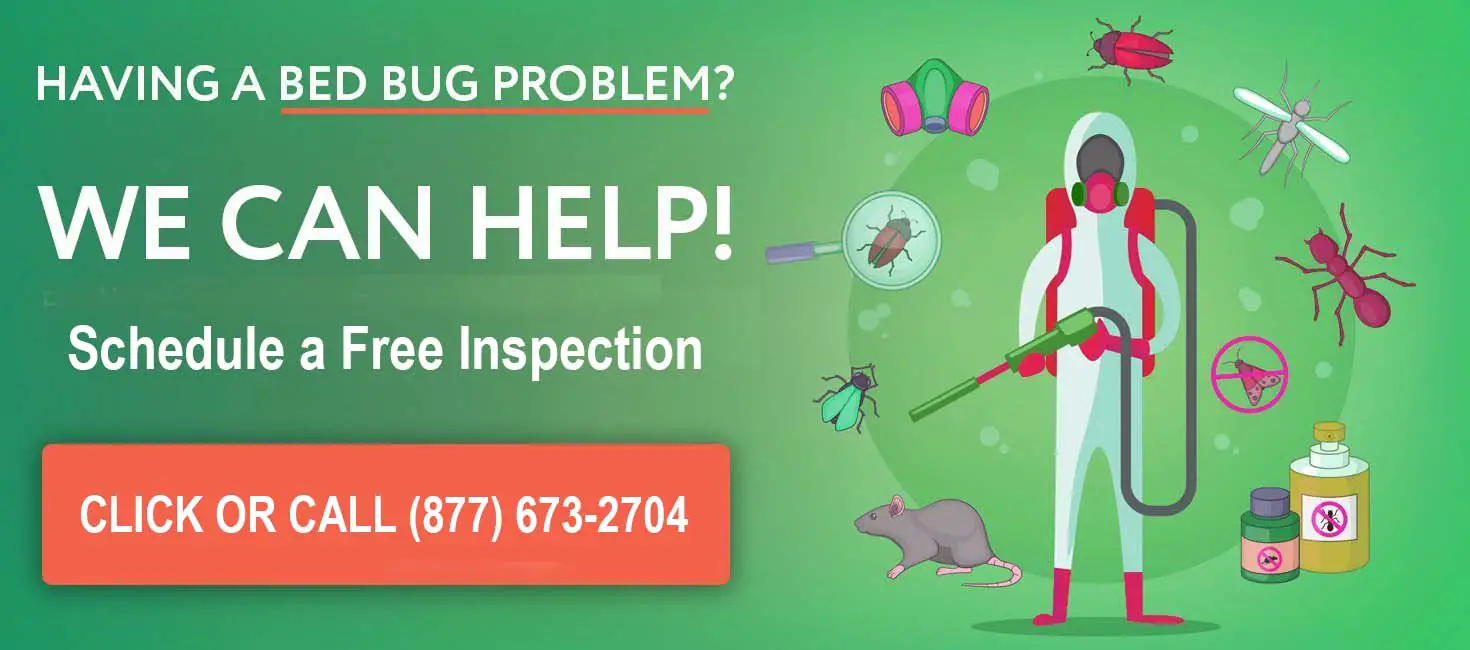"Use these pictures of bed bugs to help you identify if you have a bed bug problem. Bed bugs are referred to as wingless obligate ectoparasites and change in appearance based on their life stage (egg, nymph, adult) and whether or not they are enlarged after feeding on a hosts blood. Other insects can look like bed bugs, so be sure to confirm that you actually have an infestation with other signs such as marks on a mattress or bites. The insects hide by day and feed at night. They seek warmth, which helps them locate warm-blooded hosts such as people.
To be sure, you can send a sample bug to Cornell University for confirmation or call an exterminator for an home evaluation."
When trying to determine if you have bed bugs in your home, this video from National Geographic is a good place to start. It explains how the insects live, move and what they look like.
Bed Bugs life cycle images
Bed bugs look different depending on their life stage as shown below. Each of the images are magnified with the actual size of an adult about 3/16." The insects are visible to the naked eye, however, baby bed bugs are more easily identified when using a magnifying class and flashlight.
Bed Bugs start as an egg, move through infancy (called being an Instar or nymph), followed by adulthood. They increase in length by 30% to 50% and in weight 150% to 200% after a blood meal.
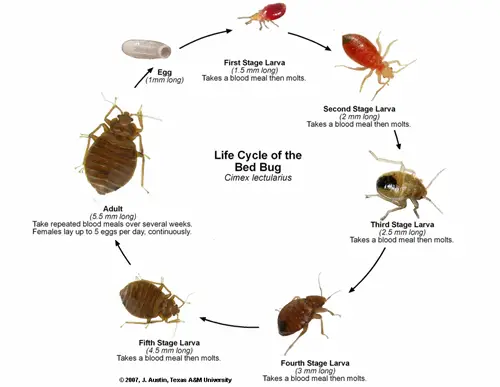 Bed bugs images at each lifestage. To lay eggs and grow, bedbugs need a blood meal. They hatch in 10 days and become adults in 2 to 4 months. (Texas A&M)
Bed bugs images at each lifestage. To lay eggs and grow, bedbugs need a blood meal. They hatch in 10 days and become adults in 2 to 4 months. (Texas A&M)The life cycle chart below shows how the bed bug appearance changes after a blood meal. Bed bugs move through 5 "molts" before becoming adults and need to feed prior to each molt. They shed skin after each molt, leaving behind another sign of an infestation.
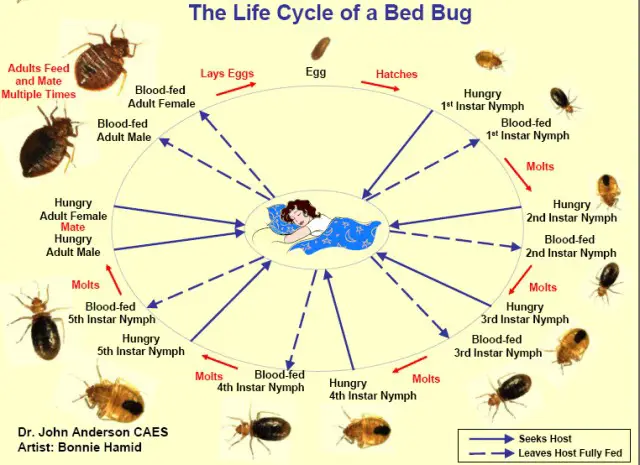 Bed bugs change in appearance from egg to nymph (young bedbug) to adult. Bed bugs can live up to 316 days. The time from nymph to adult is 5 to 8 weeks. Eggs take 10 days to hatch.
Bed bugs change in appearance from egg to nymph (young bedbug) to adult. Bed bugs can live up to 316 days. The time from nymph to adult is 5 to 8 weeks. Eggs take 10 days to hatch.Bed bugs live for approximately 10 months and move through a life cycle from egg to adult. Infestations usually start with a female bed bug who would bite the host for blood upon arrival in the bed, and then for another "meal 2 weeks later.
At that point, she would lay eggs in the home at a rate of 3 per day. It takes 2 weeks for an egg to hatch. The just born nymph looks for food right away and becomes an adult bed bug in 4 months. The speed of reproduction and total life span is affected by room temperature and what is described assumes a room at 68F (20C).
The adult bed bug lives for approximately 10-months, but can live without feeding up to a year if you decide to move to another room. A typical infestation has between 4 and 500 bed bugs.
HOW BIG ARE BED BUGS?
Bed bug size changes at each life stage as shown below. A bed bug egg is 1/32" long. Adult bed bugs size that has not fed will be about 3/16". After feeding the body swells and grows in length to about 1/5" to 1/4".
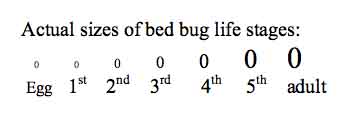 Size Comparison of Bed Bugs at Each Life Stage
Size Comparison of Bed Bugs at Each Life Stage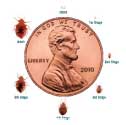 Bed Bug Actual Size Compared to Penny at Each Life Stage
Bed Bug Actual Size Compared to Penny at Each Life StageBed bugs have a flat, oval-round body shape and have 6 legs.
 Photos of Bed Bugs - Actual Size Before After Being Fed Blood Meals
Photos of Bed Bugs - Actual Size Before After Being Fed Blood Mealsbed bug eggs
Bed bug eggs are sized about the size of a pin head. They are pearl white in color and have a reddish eye spot if the eggs are 5 days or older.
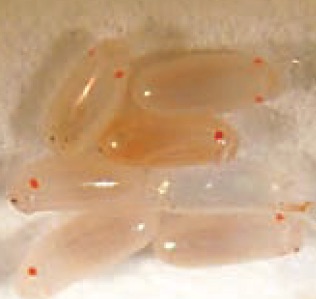 Bed Bug eggs are the Size of a Pinhead. After 5 Days They Have Eye Spots.
Bed Bug eggs are the Size of a Pinhead. After 5 Days They Have Eye Spots.Eggs are white in color and slightly round and are 1mm long. Over their 10 month life span a female will lay 200 - 500 eggs in groups of 1 to 5 eggs per day and appear to be glued onto each surface. Eggs cannot be picked up with a vacuum cleaner. The best way to kill them is either by heating a room to over 120 degrees or by using a steamer that can get hot steam into contact with the egg's surface.
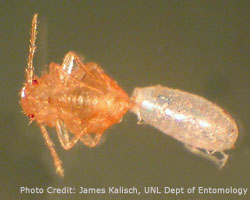 Pictures of Bed Bugs: Bed Bug Hatching from Egg
Pictures of Bed Bugs: Bed Bug Hatching from EggSource: UNL Department of Entomology
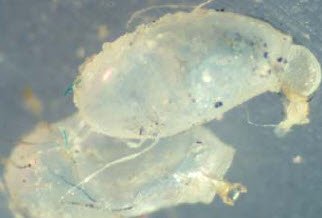 Enlarged Image of Bed Bug Eggs
Enlarged Image of Bed Bug Eggs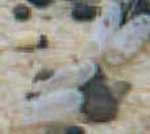 Closeup Image of Bed Bug Eggs
Closeup Image of Bed Bug Eggs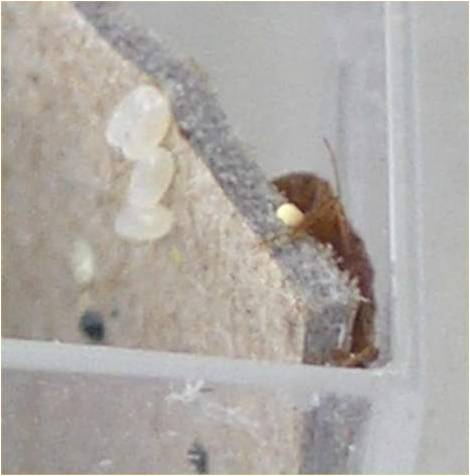 Picture of Bed Bugs Eggs Attached to a Surface
Picture of Bed Bugs Eggs Attached to a Surfaceyoung Bed Bug photos: baby bedbugs and nymphs)
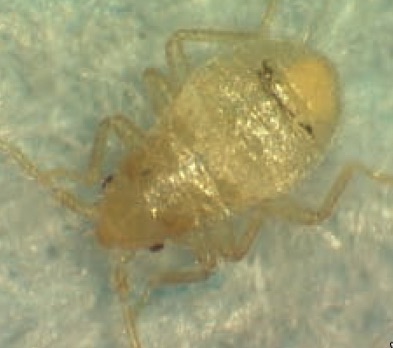 Bed Bug Nymphs are Straw color. The first Instar Nymph is small and the most difficult to see. After feeding they turn reddish in color making them easier to spot.
Bed Bug Nymphs are Straw color. The first Instar Nymph is small and the most difficult to see. After feeding they turn reddish in color making them easier to spot.Bed bugs move through 5 nymph phases (baby bed bugs) before reaching adulthood. The insects need to drink a blood meal to move from phase to phase. A nymph can live for 3 to 4 months while they wait for a human or animal to feed on.
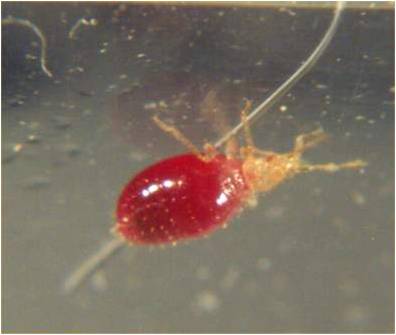 Bed Bug Nymph After Feeding
Bed Bug Nymph After Feeding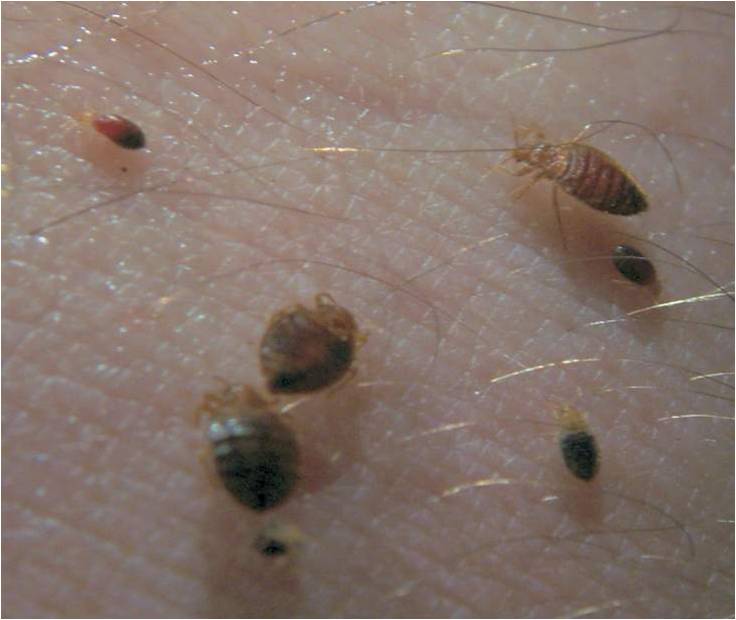 Nymph and Adult Pictures of Bed Bugs
Nymph and Adult Pictures of Bed Bugs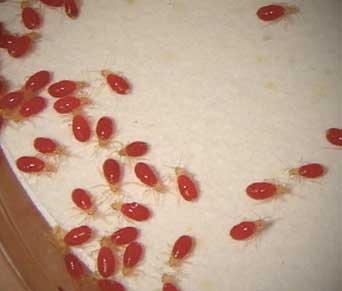 Picture of Baby Bed Bugs (called Nymphs)
Picture of Baby Bed Bugs (called Nymphs)Adult Bed Bugs
An adult bed bug is brown until it feeds on a human or animal host. After feeding the adult changes color into a dull red/dark brown. Bedbugs are 3/16 of an inch in length, about the size of an apple seed (longer after a blood meal as depicted below). Before feeding they can appear to be a flat disc while after feeding the body engorges and becomes larger as if it was a balloon.
Bed Bugs have what are called Vestigial wings (not fully developed), but can't fly. The bugs are covered by thin golden hair. Male bed bugs have a pointed abdomen while females have a rounded abdomen. An adult female bed bug can live as long as 277 days without feeding.
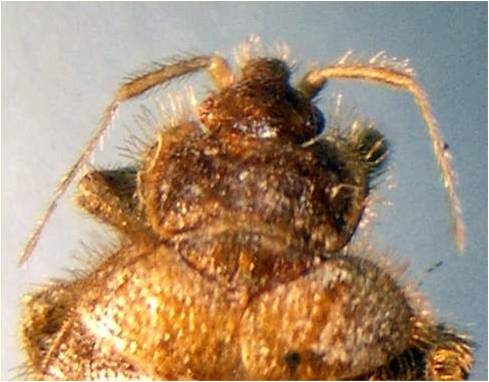 Up Close Dorsal View of Bed Bug
Up Close Dorsal View of Bed Bug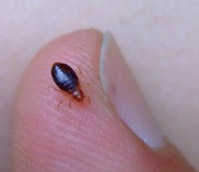 Bed Bug on Person's Thumb
Bed Bug on Person's ThumbMale and Female Adult Bed Bugs
There is a difference between the body shape of a male and female bed bug.
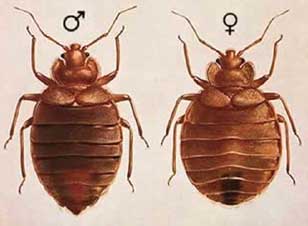 Bed Bug Pictures Depicting Female (left) and Male (right) Adult Bed Bugs. Males are oval shaped. Females have a more pronounced oval shape. After a blood meal appearance differences disappear.
Bed Bug Pictures Depicting Female (left) and Male (right) Adult Bed Bugs. Males are oval shaped. Females have a more pronounced oval shape. After a blood meal appearance differences disappear.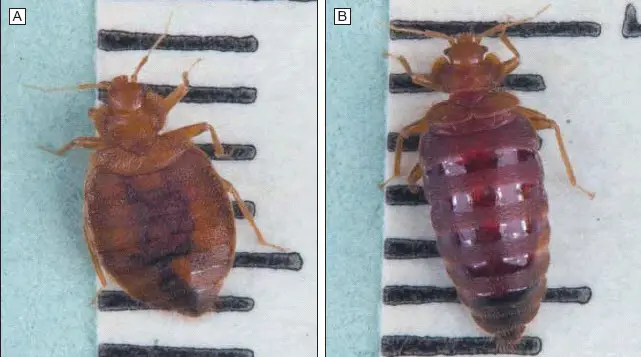 Bed Bugs Before and After Feeding
Bed Bugs Before and After FeedingPhysical Appearance for Identification
|
Color: |
Adults: Bright red after feeding, dull red if haven't fed. Baby bed bug (nymph) straw, yellow color |
|
Size: |
1/5" to 1/4", eggs 1/32" |
|
Shape: |
Oval with a flattened body. Antennae, small eyes. |
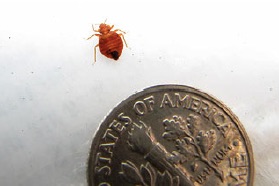 Actual Bed Bugs Size (3/16") compared to a U.S. Dime
Actual Bed Bugs Size (3/16") compared to a U.S. Dime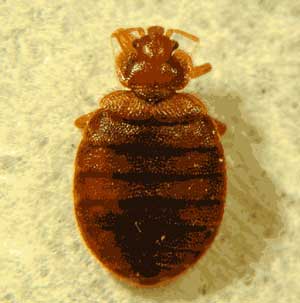 Magnified View of Bed Bug
Magnified View of Bed BugBed Bug Photo- Flat View
 The Flat Profile Enables Bedbugs to Hide in Narrow Cracks
The Flat Profile Enables Bedbugs to Hide in Narrow Cracks Side View
 Bed Bug Side View University of Florida
Bed Bug Side View University of Florida Bed Bug Feeding on Skin
A bed bug only feeds on the skin for up to 10 minutes. One bug may make multiple bites. Each bed bug will feed every few days and then move back to their hiding place until they need to feed again.
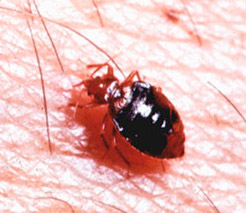 Bed Bug on Skin
Bed Bug on Skinsigns of bed bugs in the home
Bed bug infestations occur near where there is a sleeping or still human host, which is why the bedroom is the first place to look. The den or areas where you entertain are a secondary area for bed bug problems, with insects entering the home on the clothes of visitors.
Bed Bugs on A Mattress
Bed bugs are attracted to the carbon dioxide we give off when sleeping. A typical bug will feed for 10 minutes every 3 to 4 days. After feeding they will crawl back into a crack or crevice that is nearby such as a mattress seam. Most bugs will live in or near a mattress. When infestations get large they will spread to the headboard, cracks in the bed frame and then in places around the bed. Their small body and thin profile make it easy to hide.
Favorite hiding places include the headboard, box spring, bed frame, and under any mattress tags.
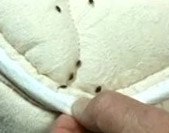 Bed Bug Infestation On Mattress (Actual Size)
Bed Bug Infestation On Mattress (Actual Size)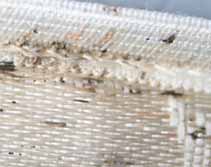 Picture of Bed Bug Fecal Smears and Blood Stains on Mattress
Picture of Bed Bug Fecal Smears and Blood Stains on Mattress 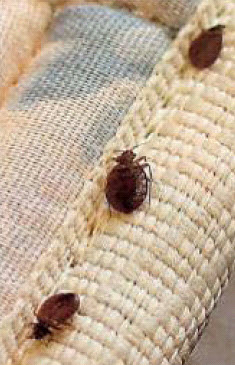 Pictures of Bed Bugs on Mattress
Pictures of Bed Bugs on Mattress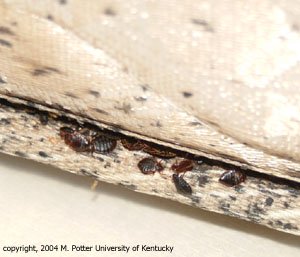 Bed Bug Infestation Sign in Mattress Seam
Bed Bug Infestation Sign in Mattress SeamBed bugs leave behind fecal or blood stains on a mattress or nearby linen. This is one of the best ways to determine if you may have a bed bug problem.
Be sure to inspect the mattress AND the box spring. Look for signs of bed bugs under the fabric which covers the bottom of the box spring.
Inspect bed sheets and keep them off the floor since insects may climb after emerging from nearby hiding spots.
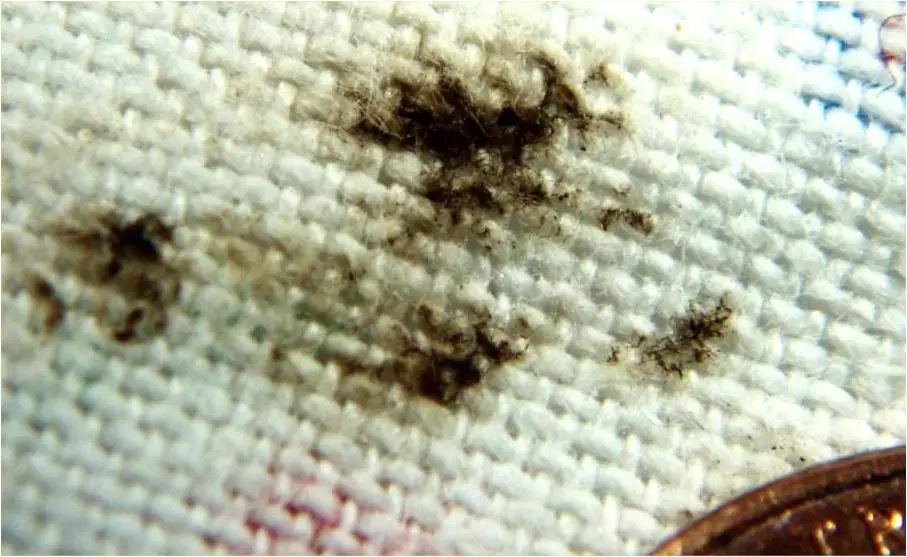 Bed Bugs Mattress Problem - Look for Stains. Human blood contains water that causes excess waste liquid. The digested blood is deposited where ever the bed bug goes after feeding is complete. Black spots are from digested blood.
Bed Bugs Mattress Problem - Look for Stains. Human blood contains water that causes excess waste liquid. The digested blood is deposited where ever the bed bug goes after feeding is complete. Black spots are from digested blood.Where to look for Fecal Spots:
Fecal spots like those above are usually found:
- Along mattress seams
- Under the mattress tag
- Crevices in box spring and under covering fabric on bottom of box spring
- Behind the head board
- Carpet edges
- Along the baseboards of the floor
- Behind pictures
- Around electrical and phone outlets
- Curtain seams or near the rod
- Loose wallpaper
- Behind hanging pictures
- Holes that connect one apartment to another
As the insects move through different phases they molt their skin. You can see the skin in the areas listed above.
Signs of Bed Bugs On Furniture and Appliances
Hiding in used furniture is a common way for bed bugs to enter the home. Often, when a homeowner has a bed bug infestation, they will discard unmarked. Unsuspecting individuals will carry the furniture home along with the bed bugs. Furniture rental companies are also aware of the problem and are supposed to inspect furniture before renting it out to a new individual.
There is even a problem with new furniture if the same truck is being used to cart away old furniture or a mattress. Bed bugs can jump from the old to the new.
Bedbugs are flat and can cling to surfaces on any angle. A homeowner needs to check behind every crack and crevice and in seams to make sure all the bugs are disposed of.
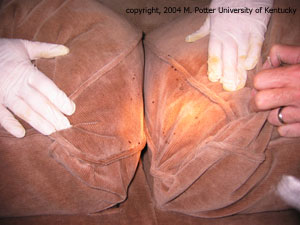 Bed Bugs Hiding On Furniture
Bed Bugs Hiding On FurnitureSource: University of Kentucky
 Signs of Bed Bugs on Furniture Include Eggs, and Insects Hiding in Seams
Signs of Bed Bugs on Furniture Include Eggs, and Insects Hiding in SeamsBe sure to inspect all furniture. Be sure to empty and bag the contents of drawers so that you can turn them over during the inspection process. Only move contents into sealed bags. Every item should be inspected for bugs.
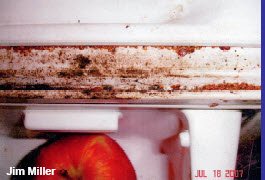 Pictures of Bed Bugs on Refrigerator Edge
Pictures of Bed Bugs on Refrigerator Edge Signs of Bed Bugs on Chair Fabric
Signs of Bed Bugs on Chair FabricBed Bug rash and Bites
Bed bugs are not known to spread disease. Reactions on the arm from a bed bug bite are due to an allergic reaction. Not everyone reacts to the bed bug bites. Cutaneous or skin reactions range from a small raised red area to blistering of the skin.
A bed bug bite is an allergic skin reaction. Some people are not allergic to bed bug bites and will show no skin reaction. Others are highly allergic and will experience red skin bumps, irritation, and rash. Severe cases result in rashes and blisters.
Common symptoms:
- 2 to 5 mm pruritic maculopapular erythematous lesions at feeding sites (raised red skin bumps)
- Complex reactions such as bullous rash or urticaria
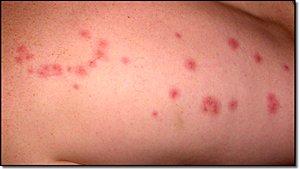 Typical Bed Bug Bites
Typical Bed Bug Bites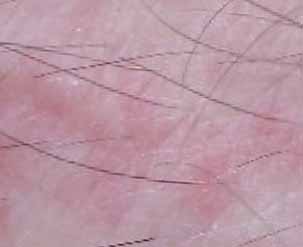 This Picture of Bed Bug Bites Results in a Skin Rash 30 Mintutes After Bite. Skin Reactions Can Appear Up to 24 Hours After Being Bitten Usually Lasts for 1 to 2 Days.
This Picture of Bed Bug Bites Results in a Skin Rash 30 Mintutes After Bite. Skin Reactions Can Appear Up to 24 Hours After Being Bitten Usually Lasts for 1 to 2 Days.While bed bugs will bite anyone, they only leave red, irritated skin reactions on people that are allergic to the bites. This is why two people sleeping in the same bed can experience no symptoms, or only one of the two people will see symptoms.
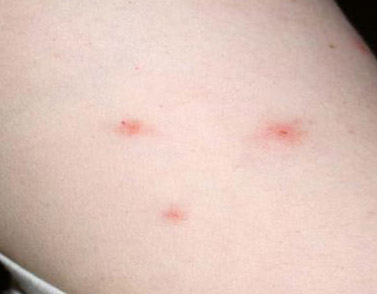 Picture of Bed Bug Bite
Picture of Bed Bug BiteBed bugs tend to bite in neat rows, usually along the seam of a bed, while sleeping. Technically they don't bite, but puncture the skin and withdraw blood. Reactions to bed bug bites tend to get worse during each subsequent biting incident. Even if a person doesn't react the first time, they may react the next time they are bitten. Bites should resolve themselves in a few days with no treatment. It itchy, an over-the-counter itch cream such as Aveeno can be used until they heal.
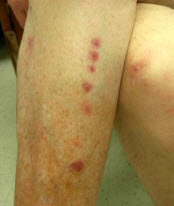 Photo of Single Line Bed Bug Bites Pattern on Leg
Photo of Single Line Bed Bug Bites Pattern on LegA more severe reaction to a bedbug bite could result in blisters.
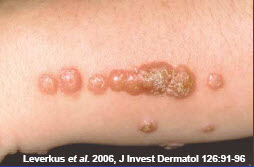 Photo of a Bed Bug Bite that Results in a Blister Skin Reaction to Bed Bug Bites
Photo of a Bed Bug Bite that Results in a Blister Skin Reaction to Bed Bug Bites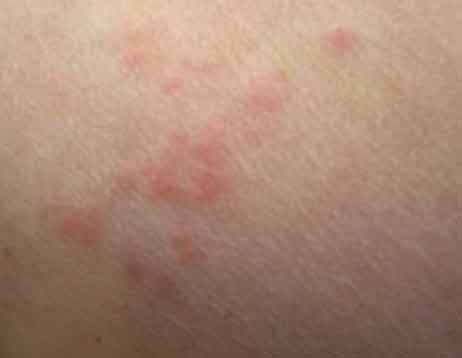 Bed Bug Bites Are Allergic Reactions That Range From Someone Having No Reaction to Small Skin Pumps and a Rash. In Rare Cases a Bite Could Result in Skin Blisters. Show Above is a Typical Bite Reaction. Most Allergic Reactions Heal on Their Own With No Treatment in Under 2 Weeks.
Bed Bug Bites Are Allergic Reactions That Range From Someone Having No Reaction to Small Skin Pumps and a Rash. In Rare Cases a Bite Could Result in Skin Blisters. Show Above is a Typical Bite Reaction. Most Allergic Reactions Heal on Their Own With No Treatment in Under 2 Weeks.bedbugs in hotels
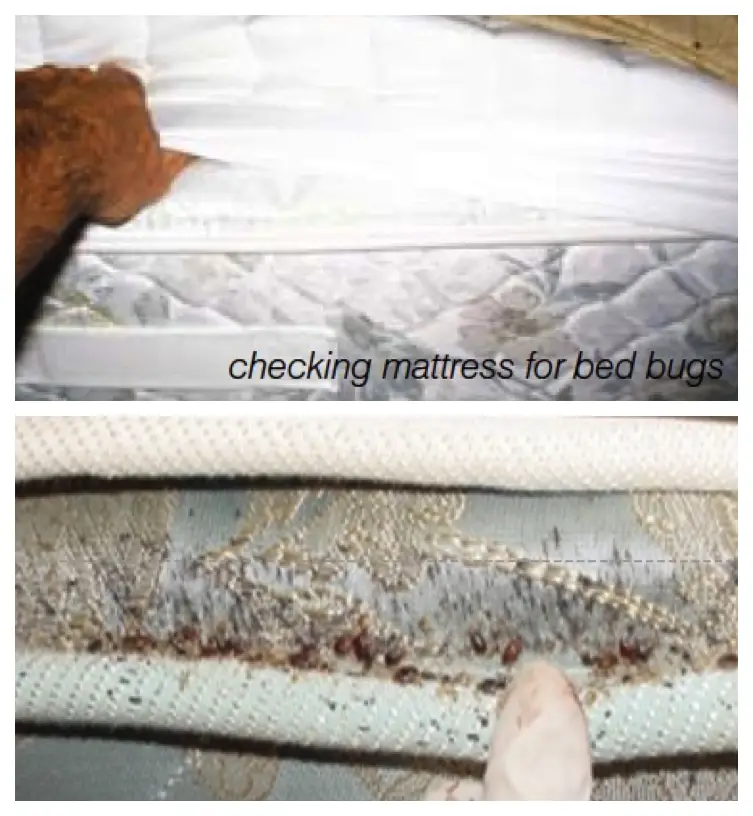 Before bringing your luggage into a hotel room, inspect the mattress. Clean mattress seams indicate that there are no bed bugs present. If you see any stains such as black or red streaks, or actual insects deep in the seems, exit the room and call hotel management.
Before bringing your luggage into a hotel room, inspect the mattress. Clean mattress seams indicate that there are no bed bugs present. If you see any stains such as black or red streaks, or actual insects deep in the seems, exit the room and call hotel management.How to Get Rid of Bed Bugs
If you can afford it, we always recommend calling in bed bug experts that know how to treat the types of bed bug infestations found in your community. It can take 2 to 3 treatments to get rid of an infestation. If you decide to hire an exterminator, ask specifically about their bedbug experience and what equipment and approaches will be used. Ask if the company will provide a written guarantee and what chemical (insecticides), organic and mechanical methods (vacuuming, steam, freezing spray, heat treatment) are used.
Since treatment can cost $1,000 or more,, it pays to get more than one quote. Start with a request to Home Advisor or by called eLocal at (1.877.233.1145), since they pre-screen local contracts before they can join the network and will provide up to 4 free quotes. Another option is to search our bed bug exterminator database.
If you cannot afford to hire experts, then our best advice is that if you want to try it yourself, purchase a kit that contains an instruction book, spray, powder, steamer and zippered mattress covers. A kit that contains everything you need including the multiple types of products needed is available from Bed Bug Supply.
For more information see our guide on how to get rid of bed bugs.
NOT SURE IF YOU HAVE A BED BUG PROBLEMs?
Not sure you have a bed bug infestation? Trouble evaluating your problem based on these pictures? One good way to evaluate a bed bug is to complete this form and send to the Cornell Diagnostic Lab, with a sample bug for evaluation. See this page for more bed bug photos.
Remember that each bed bugs picture will be different from being a baby bed bug or nymph through adulthood.
CALL A BED BUG EXTERMINATOR
Bed bugs are difficult to exterminate. It's preferable to call in an expert who can confirm the presence of a bed bug problem, who knows how to conduct a proper inspection, and who uses specialized equipment to treat the problem. The bugs multiply quickly so be sure to act as soon as you think you have a problem.
Start by either getting a free quote from a reputable company like Home Advisor (call 877-673-2704) or check our list for a local bed bug exterminator near you. Only use companies that have specific expertise in treating bed bugs.
FAQ
Are bed bugs visible to the eye?
Yes, adult bed bugs are visible to the naked eye. Eggs are the size of a pin head with an engorged adult being as large as 3/16".
What do bed bug bites look like?
A bed bug bite is an allergic skin reaction that looks like a small red raised area with a clear center where the person was actually bitten.
Where do bed bugs hide on your body?
Bed bugs do not hide on the human body or burrow into the skin. They had in narrow crevices of the bed, headboard and other areas where they can find a human host.
what other insects look like bed bugs?
Bed bugs look like and are mistaken for carpet beetles, spider beetles, cockroach nymphs (young cockroaches), ticks, and fleas.
what causes bed bugs?
Bed bugs need to be carried from one place to another which is why travelers or visitors are a common source of bed bugs. The insects can also travel from one apartment to an adjoining apartment through crevices in walls or floorboards.
Ask a Question or Share Your Bed Bug Experience With Others
Do you have a question or great story about bed bugs? Share it!
What Other Visitors Have Said About Bed Bugs
Click below to see contributions from other visitors to this page...
Finding and Getting Rid of Bed Bugs 




Bed Bugs Handbook Reader Question
Ten days ago I was bitten by a bed bug while sleeping. I know it was a bed bug because it woke me up and I found …
Neighbors Had Bed Bugs and Now I Do Too Not rated yet
I just moved on to the block 3 months ago...Me and my sister being neighborly befriended all the neighbors. One was not so friendly... the house they lived …

